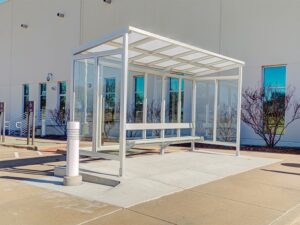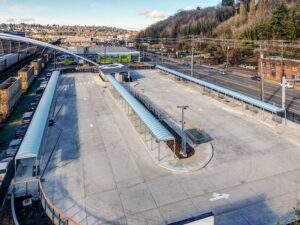Aluminum vs. Steel Shelters: Which Material Stands the Test of Time?
Choosing the right shelter material isn’t just a design decision—it’s a long-term investment in durability, maintenance, and performance. In high-traffic environments where shelter structures play a critical role in daily operations, the differences between steel and aluminum walkway covers can translate into significant cost, safety, and aesthetic implications. Whether you’re planning to install walkway covers, transit shelters, or smoking enclosures, understanding these material distinctions helps shape smarter infrastructure from the ground up.
As expectations for public and private infrastructure evolve, so does the demand for lighter, longer-lasting, and lower-maintenance materials. Aluminum has increasingly emerged as the preferred choice for many outdoor structures, particularly in applications like aluminum walkway covers, where long-term performance, weather resistance, and visual appeal all play a part.
Aluminum vs. Steel: A Structural Comparison
Both aluminum and steel offer strength and structural integrity—but their differences are clear once they’re deployed in real-world settings. Steel is known for its impressive load-bearing capacity, which makes it a go-to material in high-rise construction and heavy-duty equipment. However, this strength often comes at a cost: weight, susceptibility to corrosion, and maintenance complexity.
Aluminum, on the other hand, is lighter and naturally resistant to rust. That makes it especially valuable in outdoor installations where exposure to rain, humidity, and even de-icing salts are common. Because aluminum does not require painting or galvanizing to withstand corrosion, its performance over time remains consistent with far less upkeep.
That’s one of the main advantages of prefab shelters made from aluminum: they can be manufactured, transported, and installed more efficiently than their heavier steel counterparts—without compromising on strength or style.

Photo by Handi-Hut
The Advantage of Aluminum Canopies in Harsh Environments
Outdoor shelters live in extreme conditions. From scorching sun to subzero temperatures, every element of a shelter must be designed to hold up over years—if not decades—of exposure. That’s where the benefits of aluminum canopies becomes even more apparent.
Unlike steel, which can oxidize, flake, or require frequent refinishing, aluminum is naturally resistant to rust. This makes it ideal for coastal areas, cold-weather climates, and high-humidity regions where corrosion can compromise the structure’s integrity over time. Even in snow-prone regions where shelters are frequently treated with salts and de-icers, aluminum resists chemical breakdown with minimal maintenance required.
Aluminum is also an ideal choice for maintaining visual appeal. It can be anodized or powder-coated in a variety of finishes to match architectural aesthetics—and those finishes hold up well in UV exposure, meaning the structure keeps its color and sheen year after year.
Why Prefabrication Favors Aluminum
Prefabricated shelter systems offer time and cost savings that traditional construction simply can’t match. And when it comes to prefabrication, aluminum shines. It’s easier to cut, form, and join during the manufacturing process, which means more consistent quality and faster production times.
In applications like covered walkways, the benefits are immediate. Lightweight aluminum components can be shipped with fewer logistics concerns, assembled quickly on-site, and installed without the need for heavy lifting equipment or large crews. That translates into shorter project timelines and fewer operational disruptions.
Prefab shelters made from aluminum also include tighter quality control and better material utilization, both of which lead to less waste and more sustainable building practices—an important factor for projects with LEED or ESG goals.
Long-Term Benefits of Aluminum Walkway Covers
Durability isn’t just about surviving the elements—it’s also about maintaining performance and visual impact with minimal intervention. The long-term benefits of aluminum walkway covers include lower lifetime maintenance costs, longer service life, and reduced downtime for repairs.
Steel structures often require painting, coating, or sealing to remain corrosion-resistant—and those layers can deteriorate over time, especially in high-traffic or outdoor locations. Aluminum eliminates that need. Its resistance to moisture, mold, and rust makes it virtually maintenance-free. A simple wash is usually enough to keep it looking new.
That low-maintenance appeal is especially valuable in public spaces like transit hubs, campuses, and healthcare environments, where uptime and appearance are critical. From transit shelters to smoking shelters, aluminum offers a clean, modern, and lasting solution.
Supporting Campus Transportation and Urban Mobility
Smart infrastructure planning often hinges on simplicity and flexibility. Aluminum shelters provide both. Their lightweight nature and modular construction allow them to be installed in tight spaces, adjusted to varying elevations, and even relocated as needs evolve. That adaptability is crucial in efforts to enhance urban mobility and support changing transportation patterns.

Photo by Handi-Hut
On campuses, for example, where pedestrian routes, bike lanes, and shuttle services all intersect, shelter placement needs to evolve with population shifts and academic development. Aluminum walkway covers help define those paths, offer all-weather protection, and elevate the overall look and function of campus facilities. Investing in such structures not only improves the physical flow of movement—it supports broader initiatives in accessibility, sustainability, and wellness.
Whether serving pedestrians, cyclists, or transit riders, these shelters improve comfort, safety, and usability in meaningful ways. And that means more people opting for active and public transportation—an essential goal in any effort to modernize infrastructure and reduce reliance on single-occupancy vehicles.
Thoughtful Design Meets Structural Integrity
It’s not just about the material—it’s about how it’s used. Well-designed aluminum shelters aren’t simply durable—they’re also visually refined. With clean lines, customizable colors, and multiple roof styles, aluminum offers aesthetic flexibility that’s difficult to achieve with steel.
That flexibility makes it easier to integrate shelters into a wide range of architectural styles, from modern glass façades to traditional brick campuses. Aluminum shelters can be installed as stand-alone structures or linked to existing buildings, seamlessly tying into the larger environment while preserving sightlines and openness.
When durability, design, and cost-effectiveness all converge in one material, it’s no surprise that aluminum continues to gain traction in both public and private shelter projects.
Built for Performance, Backed by Experience
At Handi-Hut, we understand what it takes to create shelter systems that work—and last. We’ve been building high-performance structures for over 50 years, using materials and designs that stand up to the real world while enhancing the spaces they occupy. From bike shelters to custom walkway covers, our products are engineered for resilience, ease of installation, and timeless design.
Whether you’re planning to upgrade a campus, transit center, or municipal space, we’re here to help you find a shelter solution that checks all the boxes. Contact us to explore design options, receive a quote, or get expert input on your next project. Let’s create infrastructure that lasts—and looks good doing it.
